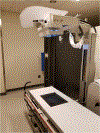Initial clinical evaluation of stationary digital chest tomosynthesis in adult patients with cystic fibrosis
- PMID: 30255248
- PMCID: PMC6896210
- DOI: 10.1007/s00330-018-5703-9
Initial clinical evaluation of stationary digital chest tomosynthesis in adult patients with cystic fibrosis
Abstract
Objective: The imaging evaluation of cystic fibrosis currently relies on chest radiography or computed tomography. Recently, digital chest tomosynthesis has been proposed as an alternative. We have developed a stationary digital chest tomosynthesis (s-DCT) system based on a carbon nanotube (CNT) linear x-ray source array. This system enables tomographic imaging without movement of the x-ray tube and allows for physiological gating. The goal of this study was to evaluate the feasibility of clinical CF imaging with the s-DCT system.
Materials and methods: CF patients undergoing clinically indicated chest radiography were recruited for the study and imaged on the s-DCT system. Three board-certified radiologists reviewed both the CXR and s-DCT images for image quality relevant to CF. CF disease severity was assessed by Brasfield score on CXR and chest tomosynthesis score on s-DCT. Disease severity measures were also evaluated against subject pulmonary function tests.
Results: Fourteen patients underwent s-DCT imaging within 72 h of their chest radiograph imaging. Readers scored the visualization of proximal bronchi, small airways and vascular pattern higher on s-DCT than CXR. Correlation between the averaged Brasfield score and averaged tomosynthesis disease severity score for CF was -0.73, p = 0.0033. The CF disease severity score system for tomosynthesis had high correlation with FEV1 (r = -0.685) and FEF 25-75% (r = -0.719) as well as good correlation with FVC (r = -0.582).
Conclusion: We demonstrate the potential of CNT x-ray-based s-DCT for use in the evaluation of cystic fibrosis disease status in the first clinical study of s-DCT.
Key points: • Carbon nanotube-based linear array x-ray tomosynthesis systems have the potential to provide diagnostically relevant information for patients with cystic fibrosis without the need for a moving gantry. • Despite the short angular span in this prototype system, lung features such as the proximal bronchi, small airways and pulmonary vasculature have improved visualization on s-DCT compared with CXR. Further improvements are anticipated with longer linear x-ray array tubes. • Evaluation of disease severity in CF patients is possible with s-DCT, yielding improved visualization of important lung features and high correlation with pulmonary function tests at a relatively low dose.
Keywords: Cystic fibrosis; Nanotubes, Carbon; Scoring methods; Tomography; X-rays.
Conflict of interest statement
Conflict of interest:
The authors of this manuscript declare relationships with the following companies: Drs. Lee, Zhou and Lu are co-inventors of the stationary chest tomosynthesis imaging system evaluated in this study. Dr. Zhou has equity ownership and serves on the board of directors of Xintek, Inc., to which the technologies used or evaluated in this article have been or will be licensed. Dr. Lu has equity ownership in Xintek, Inc. All of these relationships are under management by the University of North Carolina’s COI committees.
Figures



Similar articles
-
Stationary chest tomosynthesis using a carbon nanotube x-ray source array: a feasibility study.Phys Med Biol. 2015 Jan 7;60(1):81-100. doi: 10.1088/0031-9155/60/1/81. Epub 2014 Dec 5. Phys Med Biol. 2015. PMID: 25478786
-
Description and validation of a scoring system for tomosynthesis in pulmonary cystic fibrosis.Eur Radiol. 2012 Dec;22(12):2718-28. doi: 10.1007/s00330-012-2534-y. Epub 2012 Jun 30. Eur Radiol. 2012. PMID: 22752406
-
Second generation stationary chest tomosynthesis with faster scan time and wider angular span.Med Phys. 2025 Jan;52(1):542-552. doi: 10.1002/mp.17460. Epub 2024 Oct 16. Med Phys. 2025. PMID: 39413307
-
Chest radiographic findings in cystic fibrosis.Semin Respir Infect. 1992 Sep;7(3):193-209. Semin Respir Infect. 1992. PMID: 1475543 Review.
-
Novel imaging techniques for cystic fibrosis lung disease.Pediatr Pulmonol. 2021 Feb;56 Suppl 1(Suppl 1):S40-S54. doi: 10.1002/ppul.24931. Pediatr Pulmonol. 2021. PMID: 32592531 Free PMC article. Review.
Cited by
-
Feasibility of a prototype carbon nanotube enabled stationary digital chest tomosynthesis system for identification of pulmonary nodules by pulmonologists.J Thorac Dis. 2022 Feb;14(2):257-268. doi: 10.21037/jtd-21-1381. J Thorac Dis. 2022. PMID: 35280479 Free PMC article.
-
The correlation between point-of-care ultrasound and digital tomosynthesis when used with suspected COVID-19 pneumonia patients in primary care.Ultrasound J. 2022 Feb 22;14(1):11. doi: 10.1186/s13089-022-00257-7. Ultrasound J. 2022. PMID: 35192076 Free PMC article.
-
Phantom-based study exploring the effects of different scatter correction approaches on the reconstructed images generated by contrast-enhanced stationary digital breast tomosynthesis.J Med Imaging (Bellingham). 2018 Jan;5(1):013502. doi: 10.1117/1.JMI.5.1.013502. Epub 2018 Feb 1. J Med Imaging (Bellingham). 2018. PMID: 29430472 Free PMC article.
-
Characteristics of Carbon Nanotube Cold Cathode Triode Electron Gun Driven by MOSFET Working at Subthreshold Region.Nanomaterials (Basel). 2024 Jul 28;14(15):1260. doi: 10.3390/nano14151260. Nanomaterials (Basel). 2024. PMID: 39120365 Free PMC article.
-
QUANTIFICATION OF PULMONARY PATHOLOGY IN CYSTIC FIBROSIS-COMPARISON BETWEEN DIGITAL CHEST TOMOSYNTHESIS AND COMPUTED TOMOGRAPHY.Radiat Prot Dosimetry. 2021 Oct 12;195(3-4):434-442. doi: 10.1093/rpd/ncab017. Radiat Prot Dosimetry. 2021. PMID: 33683309 Free PMC article.
References
-
- Sly PD, Gangell CL, Chen L, Ware RS, Ranganathan S, Mott LS, et al. (2013) Risk factors for bronchiectasis in children with cystic fibrosis. N Engl J Med. 2013 May 23;368[21]:1963–70. - PubMed
-
- Cleveland RH, Sawicki GS, Stamoulis C. (2015) Similar performance of Brasfield and Wisconsin scoring systems in young children with cystic fibrosis. Pediatr Radiol. 2015 October;45[11]:1624–8. - PubMed
-
- 2016 Patient Registry Annual Data Report. Cyst Fibros Found Patient Regist. Available via https://www.cff.org/Research/Researcher-Resources/Patient-Registry/2016-...
-
- Dournes G, Menut F, Macey J, Fayon M, Chateil J-F, Salel M, et al. (2016) Lung morphology assessment of cystic fibrosis using MRI with ultra-short echo time at submillimeter spatial resolution. Eur Radiol. 2016 November 1;26[11]:3811–20. - PubMed
-
- Chou S-HS, Kicska GA, Pipavath SN, Reddy GP. (2014) Digital tomosynthesis of the chest: current and emerging applications. Radiogr Rev Publ Radiol Soc N Am Inc. 2014 April;34[2]:359–72. - PubMed
Publication types
MeSH terms
Substances
Grants and funding
LinkOut - more resources
Full Text Sources
Other Literature Sources
Medical

